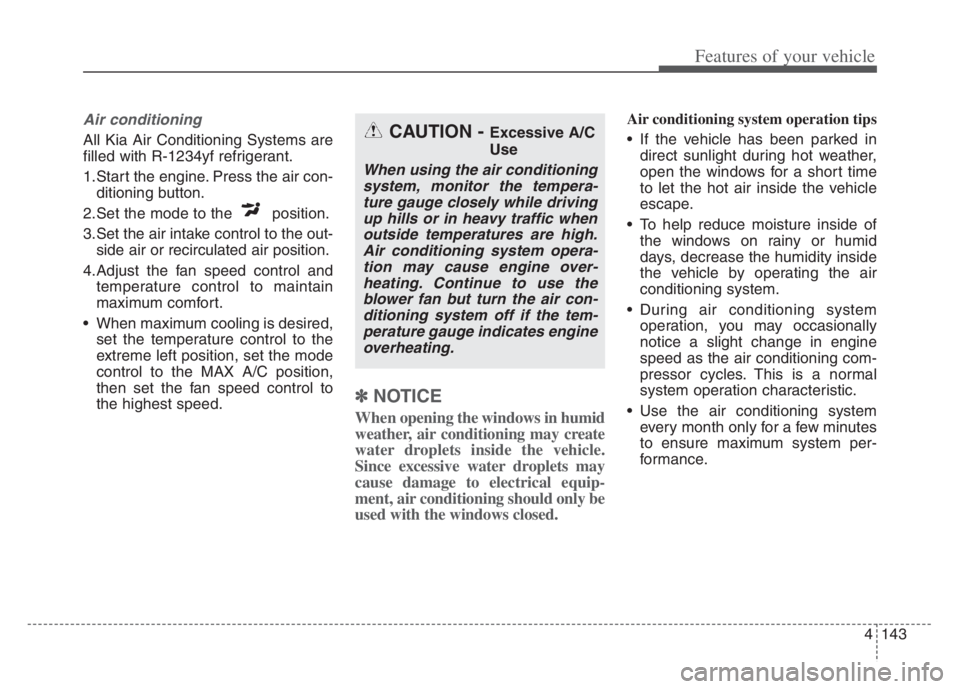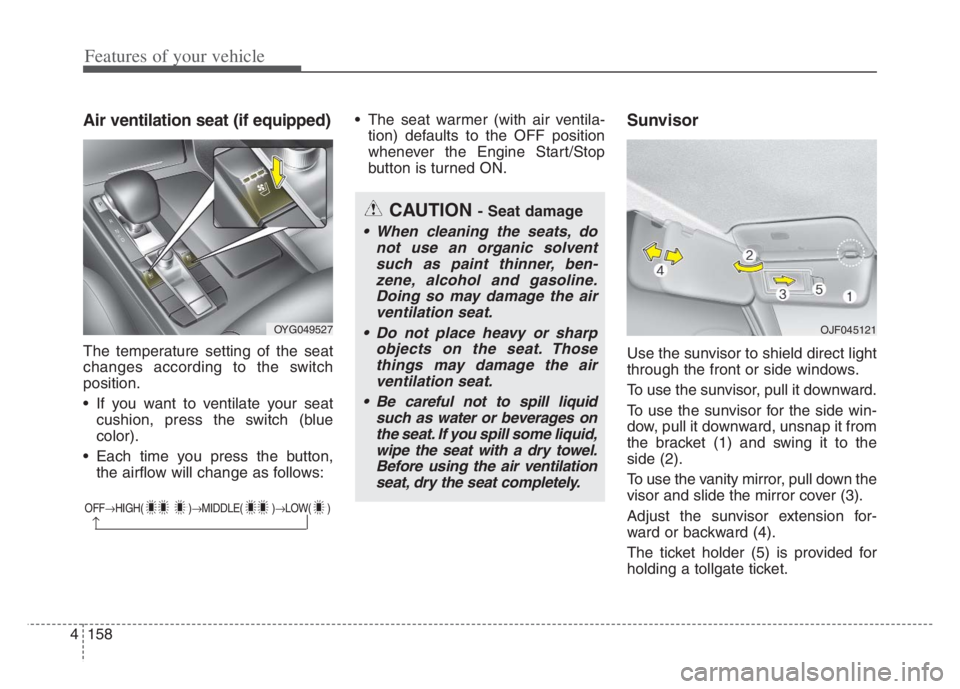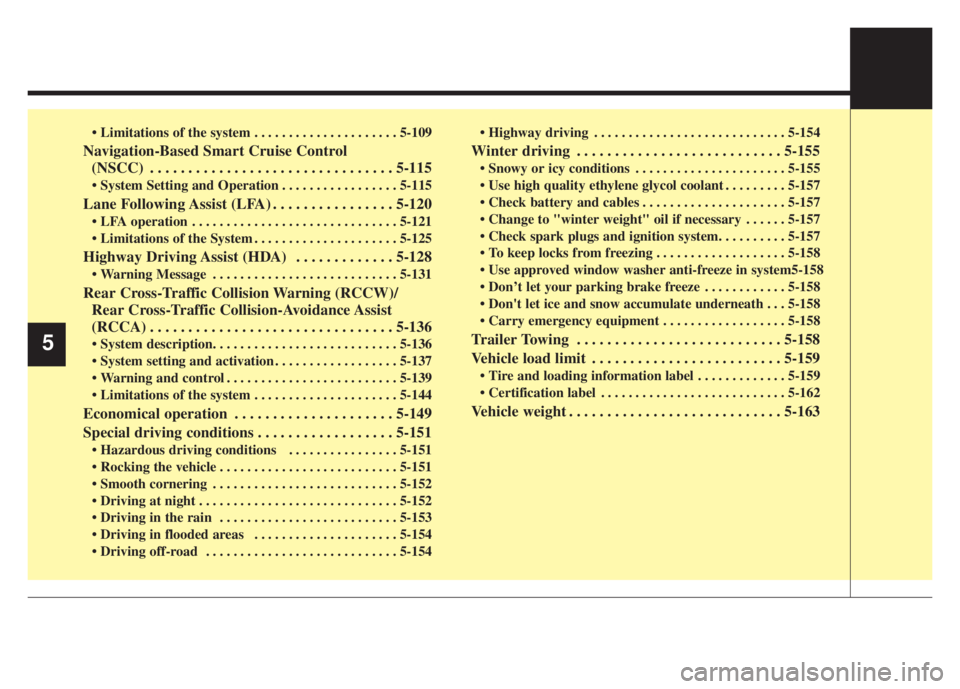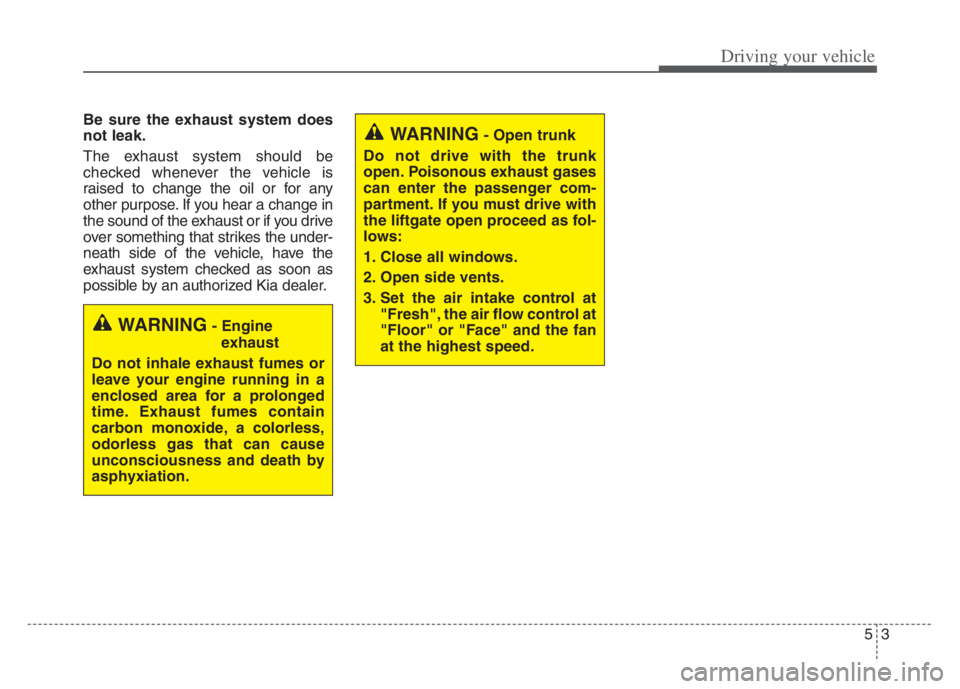window KIA CADENZA 2020 Owner's Manual
[x] Cancel search | Manufacturer: KIA, Model Year: 2020, Model line: CADENZA, Model: KIA CADENZA 2020Pages: 560, PDF Size: 11.37 MB
Page 219 of 560

4137
Features of your vehicle
The mode selection button controls
the direction of the air flow through
the ventilation system.
The air flow outlet port is converted
as follows:Face-Level (B, D, F)
Air flow is directed toward the upper
body and face. Additionally, each
outlet can be controlled to direct the
air discharged from the outlet.
Bi-Level (B, C, D, E, F)
Air flow is directed towards the face
and the floor.Floor-Level (A, C, D, E)
Most of the air flow is directed to the
floor, with a small amount of the air
being directed to the windshield and
side window defrosters.
Floor/Defrost-Level (A, C, D, E)
Most of the air flow is directed to the
floor and the windshield with a small
amount directed to the side window
defrosters.
OYG049344
Page 220 of 560

Features of your vehicle
138 4
Defrost-Level
Most of the air flow is directed to the
windshield with a small amount of air
directed to the side window defrosters.Instrument panel vents
The outlet vents can be opened or
closed separately using the thumb-
wheel (if equipped).
Also, you can adjust the direction of
air delivery from these vents using
the vent control lever as shown.
Temperature control
The temperature will increase to the
maximum (HI) by raise the toggle
switch to the extreme up.
The temperature will decrease to the
minimum (Lo) by depress the toggle
switch to the extreme down.
When raise and depress the toggle
switch, the temperature will increase
or decrease by 1°F/0.5°C. When set
to the lowest temperature setting, the
air conditioning will operate continu-
ously.
OYG049346 OYG049349
■Driver’s side■Passenger’s side
OYG049348
Page 222 of 560

Features of your vehicle
140 4
Outside (fresh) air position
With the outside (fresh)
air position selected, air
enters the vehicle from
outside and is heated or
cooled according to the
function selected.
Recirculated air position
With the recirculated air
position selected, air
from the passenger
compartment will be
drawn through the heat-
ing system and heated
or cooled according to
the function selected.Prolonged operation of the heater in
the recirculated air position (without
air conditioning selected) may cause
fogging of the windshield and side
windows and the air within the pas-
senger compartment may become
stale.
In addition, prolonged use of the air
conditioning with the recirculated air
position selected will result in exces-
sively dry air in the passenger com-
partment.Fan speed control
The fan speed can be set to the
desired speed by operating the fan
speed control switch.
To change the fan speed, raise the
switch for higher speed or depress the
switch for lower speed. To turn the fan
speed control off, press the front
blower OFF button.
OYG049352 ■Type B
■ Type A
Page 225 of 560

4143
Features of your vehicle
Air conditioning
All Kia Air Conditioning Systems are
filled with R-1234yf refrigerant.
1.Start the engine. Press the air con-
ditioning button.
2.Set the mode to the position.
3.Set the air intake control to the out-
side air or recirculated air position.
4.Adjust the fan speed control and
temperature control to maintain
maximum comfort.
When maximum cooling is desired,
set the temperature control to the
extreme left position, set the mode
control to the MAX A/C position,
then set the fan speed control to
the highest speed.
✽ ✽
NOTICE
Whenopening the windows in humid
weather, air conditioning may create
water droplets inside the vehicle.
Since excessive water droplets may
cause damage to electrical equip-
ment, air conditioning should only be
used with the windows closed.
Air conditioning system operation tips
If the vehicle has been parked in
direct sunlight during hot weather,
open the windows for a short time
to let the hot air inside the vehicle
escape.
To help reduce moisture inside of
the windows on rainy or humid
days, decrease the humidity inside
the vehicle by operating the air
conditioning system.
During air conditioning system
operation, you may occasionally
notice a slight change in engine
speed as the air conditioning com-
pressor cycles. This is a normal
system operation characteristic.
Use the air conditioning system
every month only for a few minutes
to ensure maximum system per-
formance.CAUTION - Excessive A/C
Use
When using the air conditioning
system, monitor the tempera-
ture gauge closely while driving
up hills or in heavy traffic when
outside temperatures are high.
Air conditioning system opera-
tion may cause engine over-
heating. Continue to use the
blower fan but turn the air con-
ditioning system off if the tem-
perature gauge indicates engine
overheating.
Page 231 of 560

4149
Features of your vehicle
For maximum defrosting, set the
temperature control to the extreme
right/hot position and the fan speed
control to the highest speed.
If warm air to the floor is desired
while defrosting or defogging, set
the mode to the floor-defrost posi-
tion.
Before driving, clear all snow and
ice from the windshield, rear win-
dow, outside rear view mirrors, and
all side windows.
Clear all snow and ice from the
hood and air inlet in the cowl grill to
improve heater and defroster effi-
ciency and to reduce the probabili-
ty of fogging up the inside of the
windshield.Automatic climate control
system
To defog inside windshield
1. Set the fan speed to the desired
position.
2. Select desired temperature.
3. Press the defroster button ( ).
4. The outside (fresh) air position will
be selected automatically and the
air conditioning will turn on
according to the detected ambient
temperature.
WINDSHIELD DEFROSTING AND DEFOGGING
WARNING - Windshield
heating
Do not use the or posi-
tion during cooling operation in
extremely humid weather. The
difference between the temper-
ature of the outside air and the
windshield could cause the
outer surface of the windshield
to fog up, causing loss of visi-
bility. In this case, set the mode
selection to the position
and fan speed control to the
lower speed.
OYG049356
Page 240 of 560

Features of your vehicle
158 4
Air ventilation seat (if equipped)
The temperature setting of the seat
changes according to the switch
position.
If you want to ventilate your seat
cushion, press the switch (blue
color).
Each time you press the button,
the airflow will change as follows: The seat warmer (with air ventila-
tion) defaults to the OFF position
whenever the Engine Start/Stop
button is turned ON.
Sunvisor
Use the sunvisor to shield direct light
through the front or side windows.
To use the sunvisor, pull it downward.
To use the sunvisor for the side win-
dow, pull it downward, unsnap it from
the bracket (1) and swing it to the
side (2).
To use the vanity mirror, pull down the
visor and slide the mirror cover (3).
Adjust the sunvisor extension for-
ward or backward (4).
The ticket holder (5) is provided for
holding a tollgate ticket.
OFFHIGH( )MIDDLE( )LOW( )
CAUTION - Seat damage
When cleaning the seats, do
not use an organic solvent
such as paint thinner, ben-
zene, alcohol and gasoline.
Doing so may damage the air
ventilation seat.
Do not place heavy or sharp
objects on the seat. Those
things may damage the air
ventilation seat.
Be careful not to spill liquid
such as water or beverages on
the seat. If you spill some liquid,
wipe the seat with a dry towel.
Before using the air ventilation
seat, dry the seat completely.
OYG049527 OJF045121
Page 250 of 560

Features of your vehicle
168 4
✽
✽
NOTICE
If you install an after market HID
head lamp, your vehicle’s audio and
electronic device may malfunction.
❈If your vehicle is equipped with
Infotainment system, refer to a
separately supplied manual for
detailed information.
Antenna
Glass antenna
Your vehicle uses a glass antenna to
receive both AM and FM signals.
Shark fin antenna
The shark fin antenna will receive the
transmit data.
INFOTAINMENT SYSTEM
OYG049421
CAUTION
Do not clean the inside of the
rear window glass or quarter
glass with a cleaner or use a
scraper to remove any foreign
deposits as this may cause
damage to the antenna ele-
ments.
Avoid adding metallic coating
such as Ni, Cd, and so on.
These can interfere with
AM/FM reception.
To prevent damage to the rear
glass antenna, never use sharp
instruments or window cleaner
containing abrasives to clean
the window. Clean the inside
surface of the rear glass win-
dow with a piece of soft cloth.
When putting a sticker on the
inside surface of the rear win-
dow, be careful not to damage
to the rear glass antenna.
Do not put sharp instruments
nearby the rear glass antenna.
Tinted rear window may affect
the proper functioning of the
antenna.
Page 255 of 560

• Limitations of the system . . . . . . . . . . . . . . . . . . . . . 5-109
Navigation-Based Smart Cruise Control
(NSCC) . . . . . . . . . . . . . . . . . . . . . . . . . . . . . . . . 5-115
• System Setting and Operation . . . . . . . . . . . . . . . . . 5-115
Lane Following Assist (LFA) . . . . . . . . . . . . . . . . 5-120
• LFA operation . . . . . . . . . . . . . . . . . . . . . . . . . . . . . . 5-121
• Limitations of the System . . . . . . . . . . . . . . . . . . . . . 5-125
Highway Driving Assist (HDA) . . . . . . . . . . . . . 5-128
• Warning Message . . . . . . . . . . . . . . . . . . . . . . . . . . . 5-131
Rear Cross-Traffic Collision Warning (RCCW)/
Rear Cross-Traffic Collision-Avoidance Assist
(RCCA) . . . . . . . . . . . . . . . . . . . . . . . . . . . . . . . . 5-136
• System description. . . . . . . . . . . . . . . . . . . . . . . . . . . 5-136
• System setting and activation . . . . . . . . . . . . . . . . . . 5-137
• Warning and control . . . . . . . . . . . . . . . . . . . . . . . . . 5-139
• Limitations of the system . . . . . . . . . . . . . . . . . . . . . 5-144
Economical operation . . . . . . . . . . . . . . . . . . . . . 5-149
Special driving conditions . . . . . . . . . . . . . . . . . . 5-151
• Hazardous driving conditions . . . . . . . . . . . . . . . . 5-151
• Rocking the vehicle . . . . . . . . . . . . . . . . . . . . . . . . . . 5-151
• Smooth cornering . . . . . . . . . . . . . . . . . . . . . . . . . . . 5-152
• Driving at night . . . . . . . . . . . . . . . . . . . . . . . . . . . . . 5-152
• Driving in the rain . . . . . . . . . . . . . . . . . . . . . . . . . . 5-153
• Driving in flooded areas . . . . . . . . . . . . . . . . . . . . . 5-154
• Driving off-road . . . . . . . . . . . . . . . . . . . . . . . . . . . . 5-154 •
Highway driving . . . . . . . . . . . . . . . . . . . . . . . . . . . . 5-154
Winter driving . . . . . . . . . . . . . . . . . . . . . . . . . . . 5-155
• Snowy or icy conditions . . . . . . . . . . . . . . . . . . . . . . 5-155
• Use high quality ethylene glycol coolant . . . . . . . . . 5-157
• Check battery and cables . . . . . . . . . . . . . . . . . . . . . 5-157
• Change to "winter weight" oil if necessary . . . . . . 5-157
• Check spark plugs and ignition system. . . . . . . . . . 5-157
• To keep locks from freezing . . . . . . . . . . . . . . . . . . . 5-158
• Use approved window washer anti-freeze in system5-158
• Don’t let your parking brake freeze . . . . . . . . . . . . 5-158
• Don't let ice and snow accumulate underneath . . . 5-158
• Carry emergency equipment . . . . . . . . . . . . . . . . . . 5-158
Trailer Towing . . . . . . . . . . . . . . . . . . . . . . . . . . . 5-158
Vehicle load limit . . . . . . . . . . . . . . . . . . . . . . . . . 5-159
• Tire and loading information label . . . . . . . . . . . . . 5-159
• Certification label . . . . . . . . . . . . . . . . . . . . . . . . . . . 5-162
Vehicle weight . . . . . . . . . . . . . . . . . . . . . . . . . . . . 5-163
5
Page 256 of 560

53
Driving your vehicle
Be sure the exhaust system does
not leak.
The exhaust system should be
checked whenever the vehicle is
raised to change the oil or for any
other purpose. If you hear a change in
the sound of the exhaust or if you drive
over something that strikes the under-
neath side of the vehicle, have the
exhaust system checked as soon as
possible by an authorized Kia dealer.
WARNING- Engine
exhaust
Do not inhale exhaust fumes or
leave your engine running in a
enclosed area for a prolonged
time. Exhaust fumes contain
carbon monoxide, a colorless,
odorless gas that can cause
unconsciousness and death by
asphyxiation.
WARNING- Open trunk
Do not drive with the trunk
open. Poisonous exhaust gases
can enter the passenger com-
partment. If you must drive with
the liftgate open proceed as fol-
lows:
1. Close all windows.
2. Open side vents.
3. Set the air intake control at
"Fresh", the air flow control at
"Floor" or "Face" and the fan
at the highest speed.
Page 257 of 560

Driving your vehicle
4 5
Before entering vehicle
• Be sure that all windows, outside
mirror(s), and outside lights are
clean.
Check the condition of the tires.
Check under the vehicle for any
sign of leaks.
Be sure there are no obstacles
behind you if you intend to back up.
Necessary inspections
Fluid levels, such as engine oil,
engine coolant, brake fluid, and
washer fluid should be checked on a
regular basis, at the exact interval
depending on the fluid. Further
details are provided in chapter 7,
“Maintenance”.
Before starting
Close and lock all doors.
Position the seat so that all con-
trols are easily reached.
Buckle your seat belt.
Adjust the inside and outside
rearview mirrors.
Be sure that all lights work.
Check all gauges.
Check the operation of warning
lights when the ENGINE
START/STOP button is in the ON
position.
Release the parking brake and
make sure the brake warning light
goes out.
For safe operation, be sure you are
familiar with your vehicle and its
equipment.
BEFORE DRIVING
WARNING - Distracted
driving
Focus on the road while driving.
The driver's primary responsi-
bility is in the safe and legal
operation of the vehicle. Use of
any handled devices, other
equipment or vehicle systems
that distract the driver should
not be used during vehicle
operation.